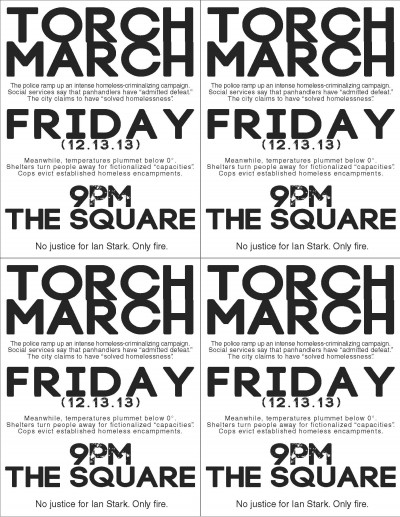Ian Stark, a 24 year old man experiencing homelessness, froze to death Tuesday night in Bloomington, IN. In response, 50-70 people took the streets on Friday night with torches, banners, spray paint and fireworks to express rage over Ian’s death. The unruly mob, mostly masked up, was comprised of anarchists, anti-prison activists, students, homeless folks, social workers, and others who knew Ian.
The march held the streets for nearly two hours, covering almost all of downtown. Participants in the march disabled several dozen parking meters, wrote graffiti, paint-bombed banks, popped tires, and distributed hundreds of fliers about Ian’s death, homelessness, and policing in Bloomington. Participants also took the opportunity to run into several yuppie restaurants and rain fliers on the passive diners.
Despite several rounds of toe-to-toe conflict with uniformed police, the emergence of at least three undercovers, and interference from a mega-douchey citizen-cop during the course of the march, we stayed tight and found our way back into the streets, lighting more torches and fireworks. No one was arrested.
Ian’s death comes at a tense time in Bloomington. Conversations about policing, surveillance and homelessness are common, as the city has recently announced that the revenue from new parking meters will fund downtown police foot-patrols and new surveillance cameras. The city aims to curb the unsightly presence of homeless people downtown, redirecting them toward social services.
From a flier distributed during the march:
“…When the city unendingly talks about the “problem of homelessness in Bloomington,” they are talking about an eyesore, an abstract liability for downtown business and the ballooning dreams of developers.
When we talk about the “problem of homelessness in Bloomington,” we’re talking about constant police harassment, the veiling of poverty, and people being turned away from shelters in below zero temperatures.
In short: we’re talking about a person freezing to death.
We’re not here in the streets tonight to beg for compassion from the cops or an increased pittance from social service agencies.
As augmented police presence, surveillance and other mechanisms of social control are deployed against the most vulnerable segments of Bloomington’s population, we too feel the effects.
Their dreams of a controlled, sanitized city will never come to pass!”

